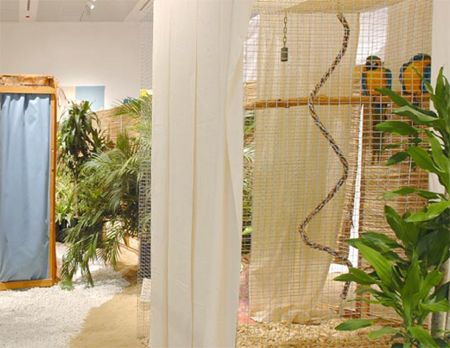Exhibition
Tropicália
A Revolution in Brazilian Culture
Sat, Jun 10–Sun, Jul 9, 2006
free admission

The exhibition presents Tropicália, perhaps the most important South American cultural movement of the last 50 years. A revolution in music, visual art, theater, and cinema that also had far-reaching effects on advertising, fashion, and TV.
The movement took its name from an experimental installation that the young artist Hélio Oiticica realized in 1967 in the exhibition New Brazilian Objectivity: a traversable wooden hut surrounded by sand – the intrusion of everyday life into the site of art. The name also became the title of one of the most famous albums in the history of Brazilian music: Tropicália ou Panis et Circensis by Gilberto Gil, Caetano Veloso, and others combined the Samba with the electric guitar. This “revolutionary” style was the origin of Tropicalismo, a musical form of criticism of the government that quickly put its protagonists in prison and then in exile. The movement’s transformational power for popular culture was nevertheless – or precisely for that reason – irreversible.Tropicália shows the pioneering moments and the complex urban and political landscape of the end of the 60s and of the 70s. The first part consists of a reconstruction of the exhibition New Brazilian Objectivity and a documentation of films and concert recordings, examples from advertising and the world of fashion, as well as stage sets and excerpts from television broadcasts. New commissioned works by musicians and visual artists like Ernesto Neto, Rivane Neuenschwander, and Marepe then address the interdisciplinary character of Tropicalismo.
Curator: Carlos Basualdo
With works by: Matthew Antezzo; Rodrigo Araujo; assume vivid astro focus; Lina Bo Bardi; Augusto de Campos (& Julio Plaza); Raymundo Colares; Antônio Dias; Hélio Eichbauer; Rubens Gerchman; Nelson Leirner; Lucas Levitan & Jailton Moreira; Anna Maria Maiolino; Marepe; Rivane Neuenschwander; Marcello Nitsche; Hélio Oiticica; Lygia Pape; Ferreira Gullar; Hans Haudenschild; Walter Smetak; Honorato Smetak; Carlos Zilio.
Tropicália: A Revolution in Brazilian Culture is co-organized by the Museum of Contemporary Art, Chicago; The Bronx Museum of the Arts, New York; and GabineteCultura, São Paulo, Brazil.
Major support for the international tour is provided by the Harris Family Foundation in memory of Bette and Neison Harris.
The international tour is sponsored by GreySocialLink; Altria Group, Inc.; and The Andy Warhol Foundation for the Visual Arts. Additional support is provided by Etant donnés: The French-American Fund for Contemporary Art.